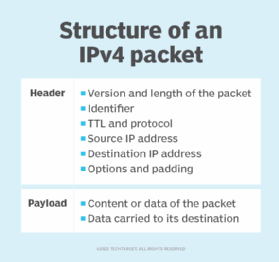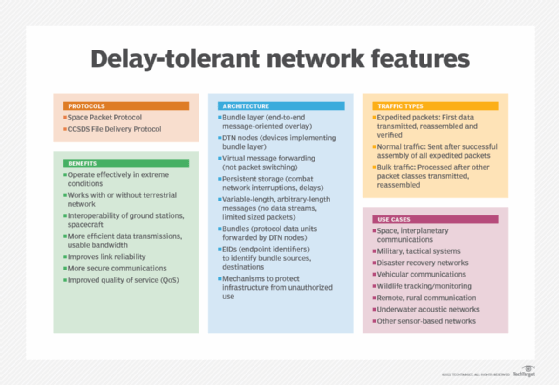delay-tolerant network (DTN)
What is a delay-tolerant network?
A delay-tolerant network (DTN) is a network that's designed to operate effectively in extreme conditions and over very large distances, such as with space communications.
In such environments, the conventional internet does not work; networks are also subject to frequent disruptions, high error rates and latency of hours or even days. A DTN can overcome such challenges and reliably transmit information, ensuring dependable internetworking.
Need for delay-tolerant networks
Introduced in 2003, delay-tolerant networks have proved most useful in deep space communications. In space, communications between Earth and spacecrafts involve long distances of thousands and even millions of miles, consequently making delays, disruptions, errors and data losses inevitable. Existing terrestrial networking technologies proved unable to handle such issues, which must be addressed at the application level. That's where DTNs come in.
The Consultative Committee for Space Data Systems (CCSDS) has developed other protocols that incorporate some aspects of delay-tolerant networking. However, they cannot provide the same level of flexibility or automated data transfer as DTNs.
Two such protocols are Space Packet Protocol and CCSDS File Delivery Protocol:
- Space Packet Protocol: This protocol can forward packets across a managed data path through the network. However, it cannot address the scheduled nature of connectivity, which may be why it has not been implemented in a space system.
- CCSDS File Delivery Protocol (CFDP): CFDP provides reliable delivery of files, but it is limited to file transfers only. It does not support messaging, streaming or other applications.
Advantages of delay-tolerant networks
DTN is a suite of protocols developed by the Delay & Disruption Tolerant Networking Research Group administered by the Internet Engineering Task Force (IETF). These protocols are versatile enough to operate either with terrestrial IP protocols or independently.

Terrestrial IP networks are based on store-and-forward operation. However, they assume that the storing will persist for only a modest amount of time, depending on the queuing and transmission delay.
DTN architecture expects nodes to store bundles for an extended period. Whenever possible, each received data packet is forwarded immediately. If forwarding is not currently possible but is expected to be possible in the future, the packet is stored for future transmission. Thus, when using a DTN, only the next hop is required to be available. Delay-tolerant networking uses this automatic store-and-forward mechanism to assure data delivery, which conventional terrestrial networks cannot do.
Other important benefits of DTNs include the following:
- enabled interoperability of ground stations and spacecraft;
- more efficient data transmissions and more usable bandwidth;
- improved link reliability;
- support for integrity checks, authentication and encryption for more secure communications; and
- ability for many priority levels to be set for different data types for improved quality of service (QoS).
Delay-tolerant network architecture
The TCP/IP protocol provides a general-purpose network- and transport-layer service for the terrestrial internet. A DTN does the same in a space environment.
The DTN architecture consists of an end-to-end message-oriented overlay known as the bundle layer. Devices implementing the bundle layer are known as DTN nodes. This layer exists above the transport (or other) layers of the network and below applications.
It provides functionality similar to the layer of gateways described in the original internet and ARPANET designs. But unlike ARPANET, the DTN bundle layer is layer-agnostic and focuses on virtual message forwarding rather than on packet switching.
The bundle layer employs persistent storage for store-and-forward. This allows it to combat network interruptions and delays. The DTN architecture uses variable-length or arbitrary-length messages instead of streams or limited-sized packets. These application data units are transformed by the bundle layer into protocol data units called bundles, which are forwarded by DTN nodes.
This communication abstraction enhances the DTN's ability to make good scheduling and path selection decisions.
In the DTN, bundle sources and destinations are identified by endpoint identifiers (EIDs), which may refer to one or more DTN nodes or endpoints. Security mechanisms are also provided in the DTN to protect the infrastructure from unauthorized use.
Traffic in delay-tolerant networks
In a DTN, traffic can be classified in three ways: expedited, normal and bulk. These traffic types move across the DTN in order of decreasing priority:
- Expedited packets. These are always transmitted, reassembled and verified before data of any other class from a given source to a given destination.
- Normal traffic. This traffic is sent after all expedited packets have been successfully assembled at their intended destination.
- Bulk traffic. This is not dealt with until all packets of other classes from the same source and bound for the same destination have been successfully transmitted and reassembled. In this sense, bulk bundles are sent on a "least effort" basis.

Applications of delay-tolerant networks
In addition to space communications and interplanetary networking, DTNs are also useful over terrestrial applications and more modest distances when interference is extreme, high error rates are common or network resources are severely overburdened.
Other key applications of DTNs include the following:
- military and tactical systems;
- disaster recovery networks;
- vehicular communications;
- wildlife tracking/monitoring networks;
- communication in remote or rural areas;
- underwater acoustic networks; and
- other sensor-based networks.
Hardware considerations for delay-tolerant networks
A delay-tolerant network can accommodate different kinds of wireless technologies, including radio frequency (RF), ultra-wideband (UWB), acoustic (sonar or ultrasonic) and free-space optical technologies. Such networks overcome network problems associated with intermittent connectivity and high error rates using store-and-forward message switching.
For this, they require hardware that can store large amounts of data indefinitely, and such media must be able to survive extended power loss and system restarts. It must also be immediately accessible at any time.
For this purpose, hard drives and high-volume flash memory are ideal. Further, the data stored on these media must be organized and prioritized by software to ensure accurate and reliable store-and-forward functionality.








